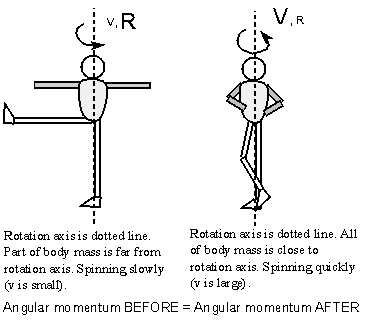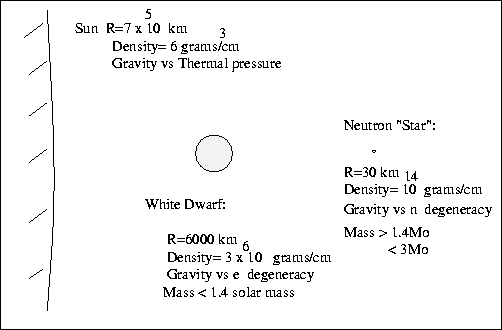Page 1 of 1
A pulsar
Posted: Fri Apr 12, 2013 11:11 pm
by saturno2
A pulsar is a neutron star. It has small diameter and high density.
But the most incredible is his speed. For example, the Crab Pulsar
has 25 km of diameter and rotates 30 times per second.
That is 1,800 times per minute.
A standard electric motor rotates 1,800 times per minute.
How, a pulsar, an astronomical object so dense, so "heavy"
can rotate at high speed?
Re: A pulsar
Posted: Fri Apr 12, 2013 11:24 pm
by Beyond
MAGIC.

Re: A pulsar
Posted: Sat Apr 13, 2013 2:11 am
by neufer
saturno2 wrote:
the Crab Pulsar has 25 m of diameter
- The Crab Pulsar ~ 25 km of diameter.
Re: A pulsar
Posted: Sat Apr 13, 2013 4:34 am
by stephen63
Listen to these pulsars. It puts it in perspective. All of that mass spinning so fast. Anything else would probably fly apart.
http://www.astro.cornell.edu/~deneva/ps ... sounds.htm
Re: A pulsar
Posted: Sat Apr 13, 2013 6:43 am
by Ann
Saturno2, do you ever watch figure skating? If so, have you noticed what figure skaters do to speed up their own rotation? First they hold out their arms from their bodies and spin slowly. Then they hold their arms close to their bodies and spin faster. Effectively, they make themselves smaller, and the rotation speed that they had when they were "large" (by holding out their arms) increases when they make themselves "small".
All known stars rotate. A pulsar is the ultra-massive core of a massive star. In the picture on the left, you can compare the size of the Sun with the size of a white dwarf and the size of a neutron star. A pulsar is a fast-rotating neutron star that is very gradually slowing down, emitting strong pulses of energy as it does so.
Pulsars are the smallest of all stars. They are also the densest of all stars, and therefore they are extremely good at withstanding the centrifugal force that would make less dense stars fly apart if they rotated as fast as pulsars.
The page from which I took the picture of the relative sizes of the Sun, the white dwarf and the neutron star, it says:
The Sun rotates at 1 rev per 30 days. Compress it to 10 km and conserve angular momentum, it would spin up to 1890 revolutions/second (and fly apart).
So a rotation speed of 1890 revolutions per second would probably be too much even for a pulsar, but a rotation speed of 30 revolutions per second is not faster than these ultra-dense stellar corpses can withstand.
Ann
Re: A pulsar
Posted: Sat Apr 13, 2013 10:30 pm
by saturno2
Thanks, Neufer
The Crab Pulsar has 25 Km of diameter
You are right
Re: A pulsar
Posted: Sun Apr 14, 2013 1:00 pm
by saturno2
Thanks
Ann and stephen63 for your important notes.
Re: A pulsar
Posted: Tue Apr 16, 2013 9:50 am
by saturno2
A baryon is a subatomic particle composed of 3 quarks.
There are 2 types of baryons: protons and neutrons.
A neutron is a baryon has 3 quarks: 2 called "dawn" and 1 called "up"
Well. In a pulsar must imagine these quarks highly compressed, leaving no vacuum space for to have high density .
Re: A pulsar
Posted: Tue Apr 16, 2013 12:35 pm
by rstevenson
saturno2 wrote:... In a pulsar must imagine these quarks highly compressed, leaving no vacuum space for to have high density .
The structure of neutron stars is quite complex and varied. For example, they have outer and inner crusts, a deeper layer of more or less uniform nuclear matter, and a core of not well understood properties. In those upper layers there can be a lattice of heavy nuclei, degenerate electron gases, superfluid neutron gases, and other exotic forms of matter. And there can be phase changes occurring too. (More than that I cannot say, since I'm already speaking well above my pay grade.

)
Rob
Re: A pulsar
Posted: Wed Apr 24, 2013 11:38 pm
by saturno2
Pulsars have different speeds of rotation from 1 time per 9.4 seconds to 716 times
per second.
A " millisecond " pulsar rotate 1,000 times or more per second.
I can not imagine an object spinning so fast.
A point in the ecuador of this type of pulsar has a linear velocity of
78,500 km/ sec ( diameter of pulsar 25 km )
78,500 km/ sec is 1/ 3.8 of the light speed
Re: A pulsar
Posted: Thu Apr 25, 2013 12:22 am
by Ann
rstevenson wrote:saturno2 wrote:... In a pulsar must imagine these quarks highly compressed, leaving no vacuum space for to have high density .
The structure of neutron stars is quite complex and varied. For example, they have outer and inner crusts, a deeper layer of more or less uniform nuclear matter, and a core of not well understood properties. In those upper layers there can be a lattice of heavy nuclei, degenerate electron gases, superfluid neutron gases, and other exotic forms of matter. And there can be phase changes occurring too. (More than that I cannot say, since I'm already speaking well above my pay grade.

)
Rob
Thanks for the info, Rob, and for your wonderfully self-deprecating way of putting it!


Ann
Re: A pulsar
Posted: Thu Apr 25, 2013 12:43 am
by rstevenson
Ann wrote:Thanks for the info, Rob, and for your wonderfully self-deprecating way of putting it!


To mis-quote Churchill, "I'm a modest man with much to be modest about."
Rob
Re: A pulsar
Posted: Thu Apr 25, 2013 12:20 pm
by saturno2
I include myself in the group of Rob ( amateur astronomers) but we want
to know more.
In my area I have no facility to study Astronomy, only Internet.
Well. I think if we ( the amateurs) have an idea of how it work a pulsar,
we can try understand something more difficult: a black hole.
Re: A pulsar
Posted: Sat May 04, 2013 11:04 am
by saturno2
The story of pulsars hides an injustice.
Joselyn Bell, a doctoral student, discovered the first pulsar.
But, Antony Hewish, his research fellow, received the award Nobel of
Physics at 1974.
Joselyn did not receive anything for to be only a " student"
I think that knowledge is for all, not " only " for academic doctors
Re: A pulsar
Posted: Sat May 18, 2013 8:41 am
by saturno2
Pulsars develop strong magnetic fields, wich can became large magnetic fields
( magneters)
Well. What is the maximum diameters of these magnetic fields of the
pulsars?


